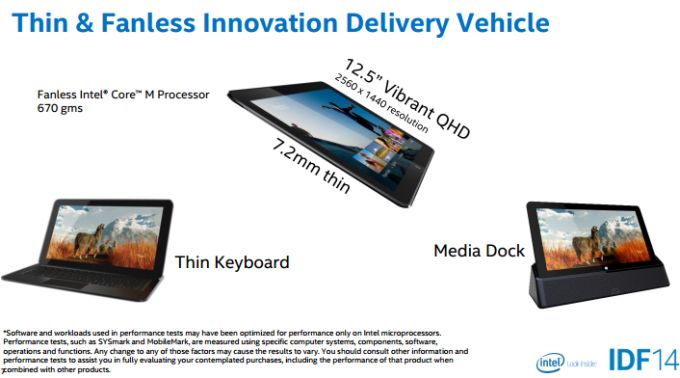Intel’s new Core M processor is a low-power, high-performance chip aimed at thin, light and fanless computers including notebooks, tablets, and 2-in-1 systems.
At least 8 portable computers with Intel Core M chips are on the way this year, and early benchmarks suggest the little tablets and notebooks won’t use a lot of power, but they’ll offer pretty strong performance.
But what does it take to build a thin, light, and fanless system? Intel provided some guidelines at a session during this week’s Intel Developer Forum.

One of the reasons you can go fanless with a Core M chip is that the processor only consumes about 4.5 watts and doesn’t generate a lot of heat. But if you want a slim and light-weight system you’ll also need a small motherboard, a thin display panel, and other components that might be more compact than parts you’d find in a normal laptop.
Intel also notes that the materials used will affect heat buildup, and that tablets or notebooks will get warmer when placed on a table than when held in a hand.
One suggestion the company makes is to place components that get the hottest such as the motherboard and CPU in area that are least likey to be touched. For example you could put the motherboard in the center of the tablet and place a battery on either side.
Ultimately the company hopes to see 2-in-1 fanless systems with Core M chips that measure less than 0.35 inches (9mm) thick and weigh less than 1.4 pounds (for a model with a 12.5 inch display).










Anything 15 inches and weighs under 3 pounds …. I’m interested.
Core M
Interested!
“leased” should be “least”
Wonder if people will flock to buy one based on the raw cost? They are not cheap and there are so MANY alternatives that are just more inexpensive and do the job. Seems like a great chip though. It also makes me wonder if you cranked up the current and ran a fan on top what the performance would be like..
The desktop dock reference design that Intel showed off has active cooling and indicated it could boost performance up to 30% when docked…
So, more than enough to close the remaining gap between it and the present Haswell U series chips, about a 13.3% gap, for CPU performance and even better GPU performance that it was already ahead of… though, this still doesn’t mean it can fully replace a desktop… it does mean it’s possible to get good enough performance for most productivity you would otherwise do on ultrabook/laptop, at least when docked…
Hoping to see some small, fanless and thin bezeled notebooks with Core M.
Same. I’ve been waiting to get the Acer TravelMate B115 (non-touch version) in the US. The bezels look small. By the time I can get one maybe fanless Core M ultraportables will be out.